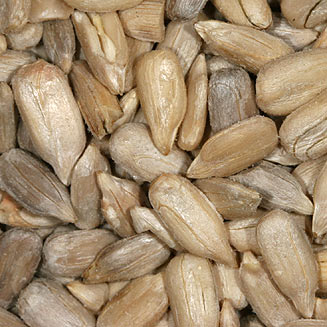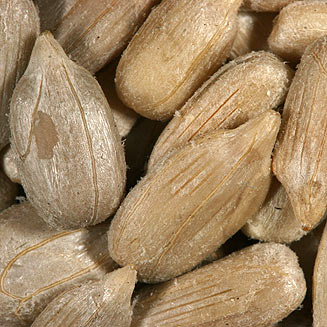|
Helianthus annuus (Sunflower)
Life
> eukaryotes >
Archaeoplastida >
Chloroplastida
>
Charophyta > Streptophytina > Plantae (land plants)
> Tracheophyta (vascular plants) > Euphyllophyta > Lignophyta (woody plants)
> Spermatophyta (seed plants) > Angiospermae (flowering
plants)
> Eudicotyledons > Core Eudicots > Asterids
> Euasterid II > Order:
Asterales > Family: Asteraceae > Genus: Helianthus
 |
 |
|
Sunflower seeds. [photo H. Robertson, Iziko
©] |
Sunflowers originate from North America and are now
grown extensively for their seeds which produce vegetable oil that is used in
cooking, salad oils and margarines. The residue after oil extraction provides a
high protein food source for livestock.
Helianthus annuus is a highly variable species that
is native to North America. Archaeological excavations show that North
American Indians had produced the beginnings of domesticated forms by 1000 BC.
The process of domestication has changed plants from being multistemmed with a
number of flower heads to ones that are tall and unbranched, with a single large
head. However, in recent years, cultivars that are shorter with smaller heads
have been developed in order to aid mechanical harvesting
Sunflowers were being grown in Europe by the mid-1500's
but it was only in the 18th century that they started being grown as an oil
crop, the initiative being taken by Russia. Russian breeders increased the oil
concentration and size of seeds as well as further increasing head size.
They also gained pest resistant genes by crossing Helianthus annuus with
wild Helianthus species. Sunflowers are now grown extensively worldwide
although it is ironic that it was only in the 1970's that largescale planting
started taking place in its country of origin in the USA. Sunflower oil has the
advantages of having high levels of polyunsaturated fats and smokes little in
frying. It is used extensively for producing salad oils and margarine. The
residue after squeezing out the oil from the seeds is used as a high protein
source for livestock.
References
-
Sauer, J.D. 1993. Historical geography of
crop plants - a select roster. CRC Press, Boca Raton, Florida.
Text by Hamish Robertson |
